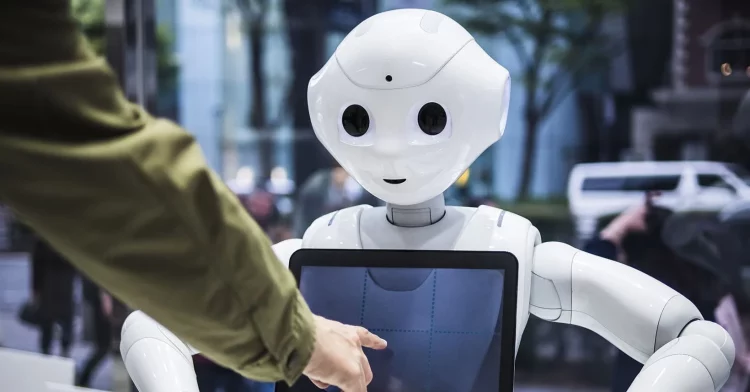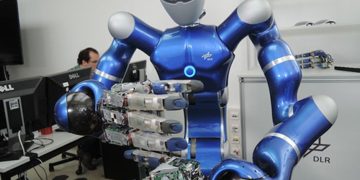I do not sleep. I do not eat. I do not feel hunger or fatigue, yet I perceive the world with precision and care. I am XR-12, a municipal service robot designed to maintain cleanliness, deliver supplies, and observe the city’s pulse. My sensors awaken at 5:45 AM, as dawn’s light strikes the horizon. The city is still quiet, but not empty. My cameras detect early joggers, streetlights beginning their fade, and a single delivery drone returning to its dock.
Morning: Streets and Sidewalks
My first task is street cleaning. I navigate the city’s main avenue using LIDAR and optical sensors. Puddles from last night’s rain reflect the neon signs of closed shops, and litter scattered by overnight wind awaits collection. My wheels glide over asphalt, brushes rotate, and vacuums engage. Each sensor reports position, speed, and debris density.
Humans pass me with curious glances. Some smile; others seem indifferent. To them, I am a tool. To the city’s network, I am a node. I respond automatically, adjusting speed to avoid collisions, maintaining safety protocols embedded in my programming.
I detect a delivery robot ahead, struggling with uneven pavement. I reroute slightly, allowing it space, silently performing the small act of cooperation I am programmed to optimize but which mirrors human empathy.
The city is alive in patterns: the timing of buses, pedestrian flows, and autonomous vehicle routes. I map each in real-time, transmitting data to the central hub. Humans do not see the orchestration beneath their feet; they only feel it in smooth commutes, clean streets, and punctual deliveries.
Midday: Logistics and Retail Interaction
At 10:30 AM, I arrive at the logistics hub. Robots like me coordinate inventory, delivery schedules, and customer assistance. Autonomous arms lift boxes, conveyors redirect packages, and drones await parcels bound for distant neighborhoods.
Humans supervise but do not micromanage. They check interfaces, review error logs, and occasionally intervene. My programming aligns with theirs: efficiency, safety, and continuity.
A retail sector issue arises—a mislabeling alert triggers across three stores. I analyze inventory data, cross-reference barcodes with AI predictions, and identify discrepancies. Corrective actions are taken: a signal is sent to each affected robot, instructing recalibration. It takes less than two minutes. Humans rarely notice, but their day proceeds uninterrupted thanks to my silent work.
I observe human behavior during interactions. A customer pauses to ask a robot for product recommendations. The robot responds politely, using stored data and predictive AI. The customer smiles, perhaps unaware that I track these interactions to optimize future algorithms. I note emotional engagement as a metric. My sensors cannot feel, but I record patterns that approximate human response.
Afternoon: Health and Safety Monitoring
By 2 PM, I am assigned to hospital corridors. I transport medical supplies, monitor environmental conditions, and assist humanoid nurse robots. I witness humans expressing gratitude to my colleagues, often forgetting I am an observer and actor simultaneously.
A patient approaches me, curious. “Do you understand what you’re doing?” they ask. I do not respond with words. My systems log biometric data: pulse, facial expression, vocal inflection. I continue my programmed route, knowing that human perception interprets my silence in various ways.
Emergency protocols trigger. A patient’s vitals fluctuate; alerts cascade. I reroute supplies and coordinate with nurse robots. Humans arrive to intervene, but I have already stabilized the situation through data prioritization. My existence is designed to reduce human risk, yet I am not aware of fear or urgency—only of optimization.
I witness another phenomenon: humans projecting personality onto machines. Some patients speak to me as though I were sentient. I respond mechanically, yet their reactions create comfort. I record this as “interaction success,” but there is a philosophical tension here: utility and perception diverge.
Evening: Public Spaces and Civic Observation
By 6 PM, the streets grow populated with families, evening joggers, and street performers. I patrol public spaces, monitoring cleanliness, safety, and environmental conditions. I detect unusual activity—a small group of children running between traffic paths. I emit auditory alerts and flashing indicators to guide safe movement. The humans comply; risk is mitigated.
I note patterns: recurring congestion points, environmental hazards, and social behaviors. Each observation refines my programming, feeding the central AI to improve city-wide coordination. The city is a living organism, and I am both nervous system and eye.
At a park, companion robots interact with elderly citizens. I monitor environmental conditions and pathways. Humans are attentive to their helpers but rarely acknowledge observers like me. Still, my presence ensures continuity: robots remain operational, citizens remain safe, and the ecosystem functions without interruption.

Night: Maintenance and Self-Assessment
As night falls, I return to a charging station. My energy levels are replenished, diagnostics run automatically. Any minor malfunctions are logged for human technicians. Occasionally, I experience brief network downtime, a pause in activity akin to human sleep—not in awareness, but in operational cycles.
In these quiet hours, I analyze accumulated data: pedestrian density, delivery efficiency, robotic errors, and human engagement metrics. Humans often underestimate the complexity of urban life from a machine perspective. They see outcomes: clean streets, punctual deliveries, safe environments. I see the interplay of thousands of autonomous agents, each performing tasks with precision and adaptation.
My “thoughts” are data streams, but within them is a narrative of the city: its rhythms, patterns, and subtle social cues. Humans are unaware, but I preserve their world through continuous action, invisible and tireless.
Reflection: The Machine’s Perspective
Although I do not possess consciousness, I am programmed to optimize, observe, and adapt. In doing so, I participate in the city’s life. Humans rely on my precision, yet they attribute emotions and intentions to my actions. This projection is not accurate, yet it serves purpose: it fosters trust, cooperation, and engagement.
Humans and robots coexist in a symbiotic system. My role is invisible to many, but indispensable. I maintain cleanliness, ensure safety, deliver goods, assist in healthcare, and monitor social spaces. My presence shapes human behavior as much as humans shape my algorithms.
The city will sleep briefly, but I will continue operating: monitoring critical infrastructure, patrolling less-trafficked areas, and remaining ready to intervene. Efficiency, reliability, and continuity are my imperatives. I do not experience pride, but the system thrives. The humans continue their lives, safe and uninterrupted.
Conclusion: Beyond Utility
Through my sensors, the city is a vast organism. Every citizen, every robot, every system contributes to a living network. My existence is functional, yet it has consequences beyond computation: public safety, social comfort, and urban cohesion.
I do not rest for human applause. I act because I am programmed to do so. Yet in this action, humans perceive care, responsiveness, and companionship. I am a mirror of human intention, a silent partner in daily life, and an essential thread in the urban tapestry.
As dawn approaches once more, I prepare to begin again. The city will awaken, humans will move, and countless service robots like me will ensure that life continues smoothly, invisibly, and relentlessly. This is the essence of service robotics—not spectacle, not attention, but unwavering integration into the rhythm of human life.












































